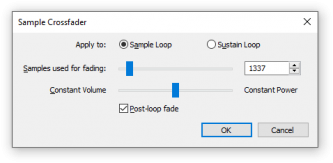Manual: Sample Crossfader
Jump to navigation
Jump to search

The sample crossfader can be used to create smooth sample loop transitions for either of the two loops of a sample. It blends the part of the sample before the loop start into the loop end to create a seamless transition. There are two main parameters to modify:
- The crossfade length determines how long the crossfade is in relation to the whole loop length. This length may not be longer than the pre-loop part of the sample, so if the pre-loop part is shorter than the loop length, the length slider is capped. If necessary, the exact amount of samples used for crossfading can be entered as well.
- The crossfade law determines how the two crossfaded signals are mixed. It can be a blend between the following two extremes:
- Constant Volume: The volume of the resulting signal is kept constant across the fade. This mode is useful for samples where the pre-loop and loop content are perfectly correlated, e.g. when crossfading small chip loops. For many uncorrelated signals, a drop in loudness may be perceived during the crossfade.
- Constant Power: The power of the resulting signal is kept constant across the fade. This mode is useful for uncorrelated samples and will ensure that the crossfade will sound equally loud. Note that the resulting signal may clip if the input signal is too loud.
- Enable the post-loop fade option to apply another crossfade after the loop end. This is useful when working with sustain loops, as the sample can be continued at the loop end without an audible gap.